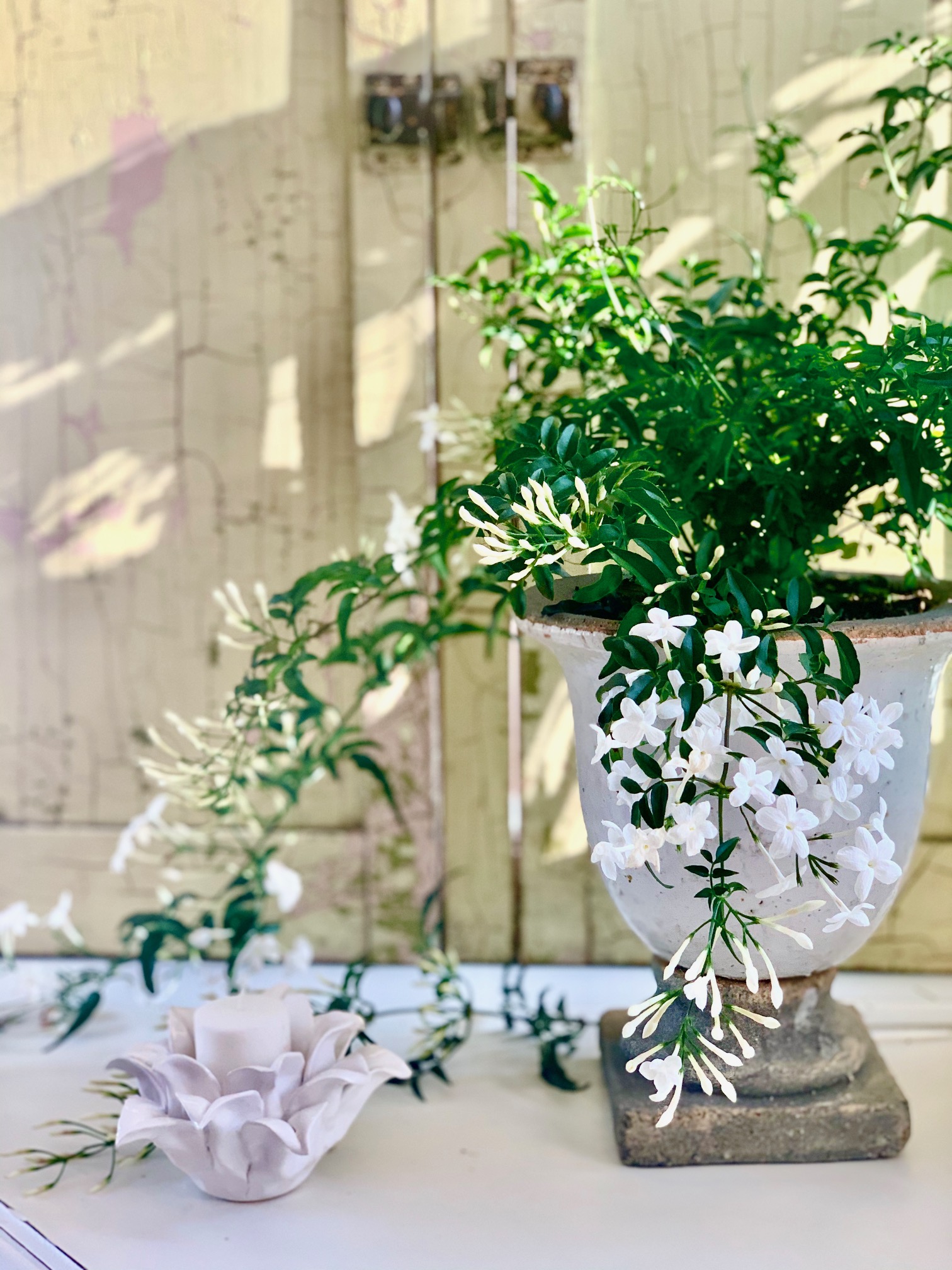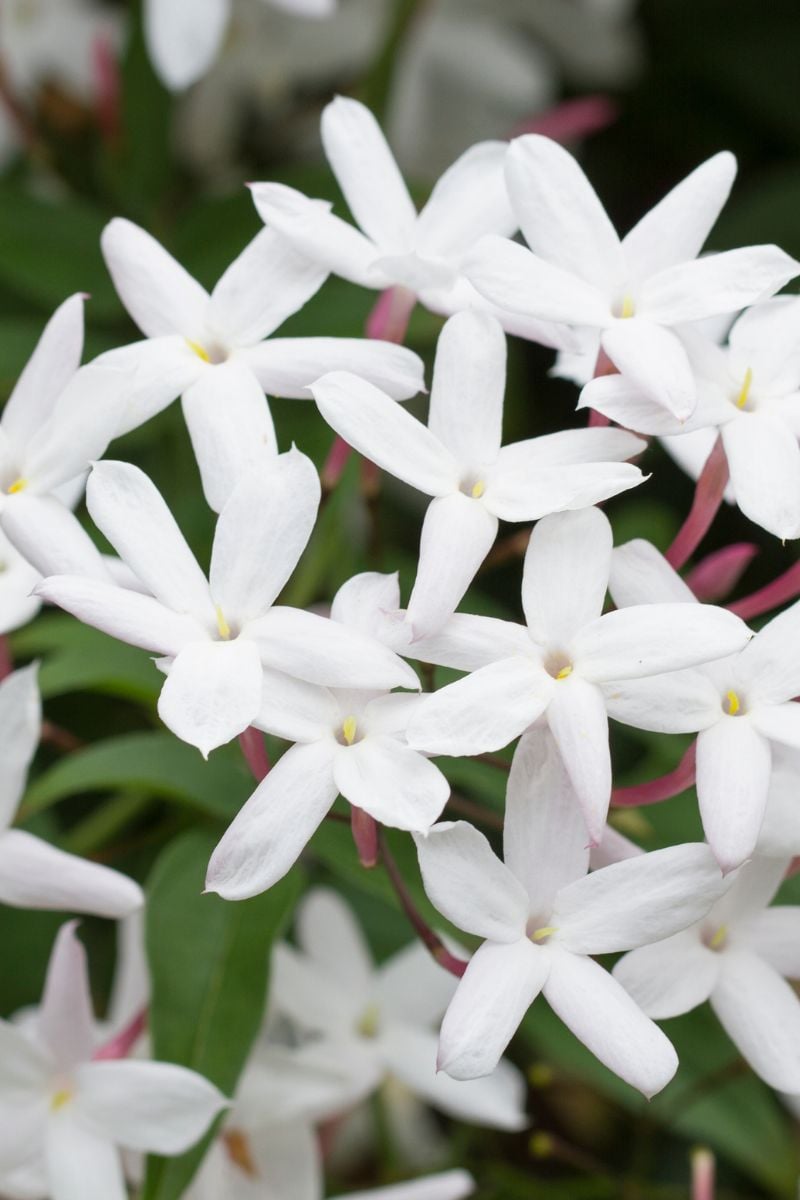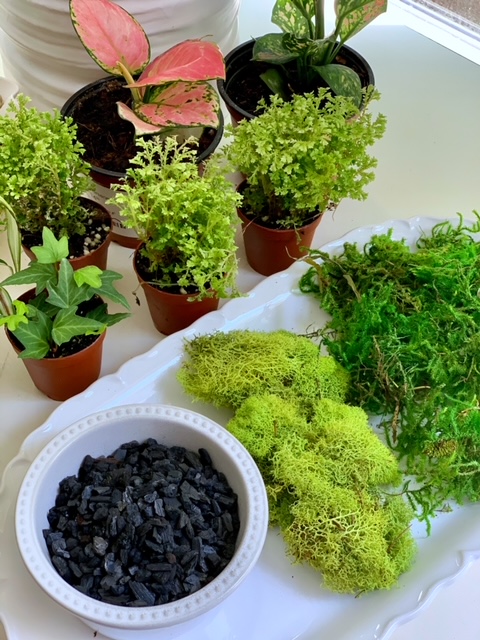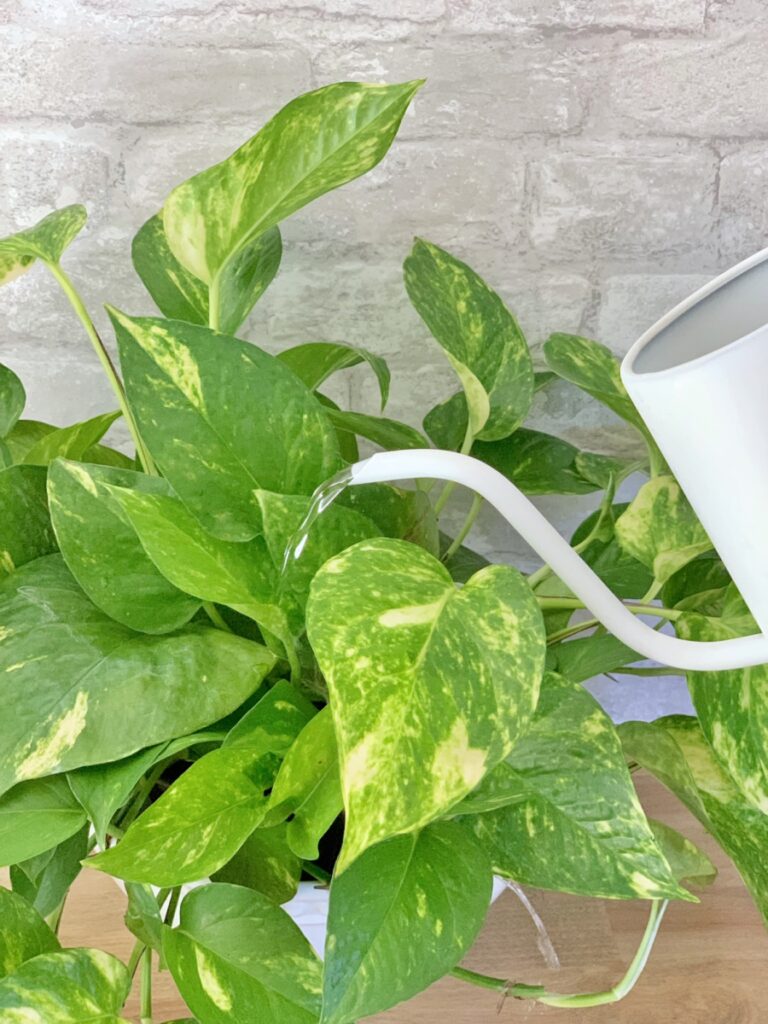Indoor jasmine plants can be a great way to brighten any room with fragrant flowers and new growth. You can keep your indoor jasmine plants happy and healthy all year round with proper care.
In this comprehensive blog post, Tips for Growing Jasmine Indoors - Tips for a Happy Healthy Plant we are going to chat all things indoor jasmine plant, from the meaning of jasmine, to why you will love this plant, to care and troubleshooting - All of it, so please read on!

*This post includes affiliate links, for more info on affiliate links visit here!
Jump to:
About Jasmine
Jasmine plants are a great addition to any plant lover's collection. With their sweet aroma and beautiful flowers, they can brighten up any room in the house. Plus, there are so many different types of jasmine to choose from, like pink jasmine, star jasmine, and winter jasmine. You can even train some varieties to climb a trellis or garden wall for a stunning display. But be warned - once you start growing jasmine plants, you may become addicted to their beauty and fragrance!
Jasmine plants have a rich history and come from many regions around the world, including Asia, Africa, and Europe. The origin of the word "jasmine" comes from the Persian word "yasmin," which means "gift from God." Jasmine has been used in many cultures for its medicinal properties, and its fragrant flowers have been used in perfumes and teas for centuries. In China, jasmine has been cultivated since the Han dynasty, and in India, jasmine flowers are used in religious ceremonies and as a symbol of love and purity. The Moors introduced jasmine to Spain in the 10th century, and it became a popular ornamental plant in European gardens during the Renaissance. Today, jasmine plants are still highly valued for their beauty and fragrance and are grown all around the world, including in tropical and subtropical regions.

The meaning of Jasmine as a gift
Jasmine has been regarded as a gift in many cultures for centuries. In some cultures, jasmine is associated with love and is given as a gift to express romantic feelings. Jasmine is considered a symbol of purity and is often used in wedding ceremonies in India. In China, jasmine is seen as a symbol of feminine sweetness and is given as a gift to women. Additionally, in some cultures, jasmine is believed to have healing properties and is given as a gift to help with ailments such as headaches and anxiety. Whatever the reason for giving it, jasmine as a gift is a thoughtful gesture that can brighten up someone's day with its beauty and sweet fragrance.

10 reasons why you will love this plant
Here are just a few reasons why you will love having a jasmine plant in your home:
- Fragrant flowers: Similar to stephanotis plants, Jasmine plants produce beautiful, fragrant flowers that will fill your home with a sweet aroma.
- Easy to grow: Jasmine plants are relatively easy to grow and care for, making them a great choice for beginner plant owners.
- Year-round blooms: Some types of jasmine, such as winter-blooming jasmine, produce blooms during the winter months, so you can enjoy their beauty even when it's cold outside.
- Climbing ability: Some varieties of jasmine, like star jasmine, can be trained to climb up a trellis or grapevine wreath, creating a stunning display.
- Medicinal properties: Jasmine has been used in traditional medicine for centuries and is believed to have a range of health benefits, including reducing stress and anxiety.
- Variety: There are many different types of jasmine to choose from, each with their own unique qualities and beauty.
- Low maintenance: Jasmine plants don't require a lot of water or attention, making them a great choice for busy plant owners.
- Beautiful foliage: Even when jasmine plants aren't blooming, their lush green foliage adds a touch of natural beauty to your home.
- Cultural significance: Jasmine has a rich history and cultural significance in many parts of the world, making it a meaningful addition to your home decor.
- Mood booster: The sweet aroma and natural beauty of a jasmine plant can boost your mood and help create a relaxing atmosphere in your home.

Best types to grow indoors
If you're looking to grow a jasmine plant indoors, here are some of the best types to consider:
- Jasminum polyanthum: Also known as pink jasmine, this variety is a popular choice for indoor growing because of its fast growth and fragrant pink and white flowers.
- Jasminum sambac: Commonly known as Arabian jasmine, this variety produces small, white flowers with a sweet aroma.
- Jasminum officinale: This variety, also known as common jasmine, produces delicate white flowers with a strong, sweet fragrance.
- Jasminum nudiflorum: Winter jasmine, as it is commonly called, produces bright yellow flowers and can bloom during the winter months.
- Trachelospermum jasminoides: Also known as star jasmine, this variety produces small, white, star-shaped flowers with a sweet fragrance and can be trained to climb up a trellis or wall.
When growing jasmine indoors, it's important to choose a variety that can thrive in indoor conditions. Look for types that can tolerate indirect light, cooler temperatures, and lower humidity levels. With proper care and the right conditions, these jasmine varieties can make beautiful additions to your indoor plant collection.

How to grow indoor Jasmine plants
Sun:
If you're planning to grow jasmine indoors, it's important to provide it with enough sunlight. Jasmine plants require bright, direct sunlight for at least 4-6 hours a day to thrive. Choose a south-facing window or a spot where the plant can receive ample sunlight. However, be careful not to expose it to direct sunlight during the hottest part of the day, as this can damage the leaves. If your home doesn't get enough natural light, consider supplementing with artificial light, such as a grow light. With the right amount of sun exposure, your jasmine plant will produce beautiful blooms and stay healthy and happy.
Soil:
Growing jasmine indoors requires the right kind of soil. Jasmine plants prefer well-drained soil that is rich in organic materials. Use a potting mix that is specifically formulated for indoor plants and has good drainage. Add peat moss or perlite to the mix to improve drainage and provide adequate aeration for the roots. Avoid using heavy garden soil or potting mixes that retain too much moisture, as this can lead to soggy soil and root rot.
Water:
To keep your indoor jasmine plant healthy and thriving, it's important to water it properly. Jasmine plants require moderate watering and do not tolerate soggy soil. Water the plant thoroughly when the top inch of soil feels dry to the touch, but make sure not to overwater. Watering once a week should be sufficient, but this can vary depending on the humidity level in your home and the size of your plant. Allow the soil to drain completely after watering to prevent root rot. It's also a good idea to mist your jasmine plant occasionally to provide it with some extra humidity, especially during the winter months when the air is drier. With the right watering routine, your jasmine plant will produce healthy foliage and beautiful blooms.
Temperature and humidity:
Jasmine plants prefer warm temperatures and high humidity, making them a great choice for indoor growing. Ideally, indoor jasmine plants should be kept in a room with a temperature range of 60-75°F (15-24°C). They thrive in humid conditions, so consider using a humidifier or placing a tray of water near the plant to increase the humidity level. Avoid exposing the plant to cold drafts or extreme temperature fluctuations, as this can damage the leaves and flowers.

Indoor plant care
Fertilizing your Jasmine plant:
Fertilizing your indoor jasmine plant can help to promote healthy growth and blooms. Use a balanced, water-soluble fertilizer every two weeks during the growing season, from late spring through early fall. Be careful not to over-fertilize your plant, as this can lead to salt buildup and damage to the roots. During the winter months, when growth slows, you can reduce or even stop fertilizing altogether. Remember always to follow the instructions on the fertilizer package and adjust your fertilization schedule based on your plant's needs.
Pruning:
Pruning your indoor jasmine plant is an important part of its care, as it helps to promote new growth and shape the plant as it grows. To prune your plant, use clean, sharp scissors to remove any dead or damaged branches, as well as any growth that is too long or out of shape. You can also pinch back the tips of the branches to encourage bushier growth. Be careful not to prune too much at once, as this can stress the plant and reduce its blooms. Prune your jasmine plant in the late winter or early spring, just before the start of the growing season. Regular pruning will help to keep your plant healthy and looking its best.
Training the Vines:
Training your indoor jasmine plant to climb a trellis or other support is a great way to add some visual interest to your space while also promoting healthy growth. To train your jasmine vines, gently wrap them around the trellis or other support structure, being careful not to damage the plant or its leaves. You can also use a grapevine wreath as a support, which will provide a natural and decorative element to your plant. As your jasmine plant grows, continue to gently guide the vines and tie them to the support structure as needed. This will help to prevent the vines from getting tangled or growing in unwanted directions.
Repotting:
Repotting your indoor jasmine plant is important to ensure that it has enough space to grow and thrive. When your plant has outgrown its current pot, it's time to repot it into a larger container. To do this, gently remove the plant from its current pot and loosen any tangled roots. Place the plant into the new pot, adding fresh soil around the edges to fill in any gaps. Be sure to choose a pot that is only slightly larger than the current one, as a pot that is too large can lead to overwatering and other problems. Repot your jasmine plant in the early spring, just before the start of the growing season. This will give it plenty of time to settle into its new container and begin producing new growth.

Does Jasmine need a trellis?
While indoor jasmine plants don't necessarily require a trellis, providing some form of support can be beneficial for their growth and appearance. Many jasmine varieties have a natural climbing or trailing habit, and a trellis, stake, or other structure can help guide their growth, prevent tangling, and create an attractive display. For compact indoor spaces, a small decorative trellis or even a simple bamboo stake can work well. However, if you prefer a bushier appearance, regular pruning can encourage fuller growth without the need for a trellis. Ultimately, the decision to use a trellis for your indoor jasmine depends on your preferred aesthetic and the specific variety of jasmine you're growing.
How to propagate
Here are some steps on how to propagate your indoor jasmine plant:
- Take a cutting: Use a clean and sharp sharp scissors or pruners to cut a stem from your jasmine plant. The cutting should be about 4-6 inches long and should have at least one or two sets of leaves.
- Remove lower leaves: Remove the lower leaves from the stem, leaving only a few sets of leaves at the top.
- Dip in rooting hormone: Dip the cut end of the stem into rooting hormone, which will help the plant to form roots.
- Plant in soil: Plant the stem in a small pot filled with moist soil. Be sure to plant it deep enough so that it is stable and won't fall over.
- Cover with plastic: Cover the pot with plastic to create a humid environment, which will help the cutting to root. Place the pot in a warm and bright location, but out of direct sunlight.
- Wait for roots to form: Check on the cutting every few days to make sure the soil is still moist. After a few weeks, the cutting should begin to form roots.
- Transplant: Once the cutting has formed a good root system, transplant it into a larger pot with well-draining soil. Keep it in a warm and bright location and continue to water it regularly until it is established.

Troubleshooting
Jasmine plants are known for being hardy and easy to care for, but sometimes even the best plant parents run into problems. Here are some common issues you might encounter with your indoor jasmine and how to troubleshoot them:
- Yellow leaves - this is usually a sign of overwatering, so cut back on watering and make sure your soil is well-draining.
- Drooping leaves - your plant might not be getting enough water, so give it a good soak and make sure the soil is moist but not soggy.
- No new growth - if your plant seems stagnant, it might need more sunlight or fertilizer to encourage new growth.
- Brown spots or powdery mildew - these can be signs of fungal diseases, so remove affected leaves and make sure your plant has good air circulation.
- Spider mites - these tiny pests can infest your plant and cause yellowing leaves and webbing. Treat with insecticidal soap or neem oil.
With a little bit of attention and care, your indoor jasmine should be thriving in no time!
Getting your plant to bloom:
Sigh, we've all been there - waiting for our beloved blooms! If your indoor jasmine plant is not blooming, it could be due to a lack of sunlight or insufficient pruning. Jasmine plants need at least 4-6 hours of direct sunlight each day to produce flowers, so make sure your plant is located in a sunny window or provide it with artificial light if needed.
Additionally, pruning can help stimulate new growth and encourage flowering. In late winter or early spring, trim back any dead or diseased branches and cut back any overgrown vines. This will promote new growth and encourage the plant to produce more flower buds.
Another tip is to make sure your jasmine plant is in the right temperature range. Some jasmine varieties, such as winter-blooming jasmine, prefer cooler temperatures to stimulate flowering.
Lastly, be patient! Jasmine plants can take a year or more to produce their first flowers, so don't give up on your plant too soon. With proper care and attention, your indoor jasmine should reward you with fragrant blooms in the growing season.

Frequently asked questions
Jasmine plants prefer warmer temperatures, but some varieties such as winter jasmine can tolerate cooler temperatures. Keep the plant away from drafts and cold windows during the winter months.
Jasmine plants need bright light to thrive and produce blooms. While they can tolerate some low light conditions, it's best to provide them with bright, indirect sunlight for the best results.
While jasmine plants can grow in a small pot, they prefer to have room to grow and may become root-bound over time. It's best to plant jasmine in a larger container with good drainage and fresh soil.
While a self-watering system can be convenient for indoor plants, it may not be the best option for jasmine plants. Jasmine plants prefer to have their soil moist but not waterlogged, and a self-watering system may not provide the right amount of water for optimal growth. Additionally, the roots of the jasmine plant need to breathe, and constant moisture from a self-watering system can lead to root rot. It's important to monitor the soil moisture level regularly and water the plant manually as needed. With the right care and attention, your indoor jasmine plant will thrive without the need for a self-watering system.
While there are some homemade fertilizer options, it's important to note that they may not provide your indoor jasmine plant with all the necessary nutrients it needs to thrive. However, if you'd like to try a homemade option, one option is to mix a small amount of compost or worm castings with water and use it to fertilize your plant once a month. Another option is to use coffee grounds, which can provide nitrogen and other nutrients to your plant. Mix used coffee grounds with water, let it sit for a few hours, and then use it to water your plant once a month. However, be cautious not to overdo it with coffee grounds as it can make the soil too acidic for your plant to grow well.
Jasmine and Gardenias are related plants in the Oleaceae family but differ in their growth habits, leaves, and flowers. Jasmine is a climber or vine with simple, elongated leaves and star-shaped flowers that are white or yellow. Gardenias are bushes with glossy, dark green leaves arranged in whorls of three or four and showy, creamy white flowers with a waxy texture. Both plants require well-draining soil and regular watering but have different temperature preferences.
The information on this question is conflicting, so proceed cautiously. However, according to ASPCA (American Society for the Prevention of Cruelty to Animals) Jasminium species are Non-Toxic to Dogs, Non-Toxic to Cats, Non-Toxic to Horses.
For more Plant-spiration 🙂 please visit these posts:
Glass Open Terrarium with DIY Stand: This post is about making a glass open terrarium with a DIY stand. The post discusses what a terrarium is and the different types of terrariums. I share the best open terrarium plants and provide a list of supplies needed for making a glass open terrarium.
How Often Should I Water a Pothos Plant?: This post provides guidance for new Pothos plant owners on how to care for their plants, including watering, lighting, pruning, propagation, and fertilizing.
Growing jasmine indoors is a fantastic way to elevate the scent and appearance of your home. Jasmine plants have an interesting history and cultural importance, plus they offer a range of options to choose from. Whether you prefer a climbing plant or one that requires less maintenance, there is a jasmine variety for you. As long as you provide proper care and sunlight, your indoor jasmine plants will reward you with sweet fragrances and stunning blooms all year round. So go ahead and add a jasmine plant to your indoor garden - you won't regret it!
Thank you for visiting the blog today for Indoor Jasmine Care: Tips for a Healthy and Happy Plant! Now get to your local plant nursery and grab yourself a beautiful Jasmine!
Keep Growing Friends!










Thank you so much for the jasmine info.......this is my second one and hopefully will survive longer than the first!!
On another note..........I am absolutely in love with the urn you have the jasmine in. Is this available anywhere for purchase? I am a huge fan and a number of my plants are as well!
Hi Donna, thank you its one of my favorites too! I bought it a few years ago at a local home decor shop so unfortunately I cant source it for you.